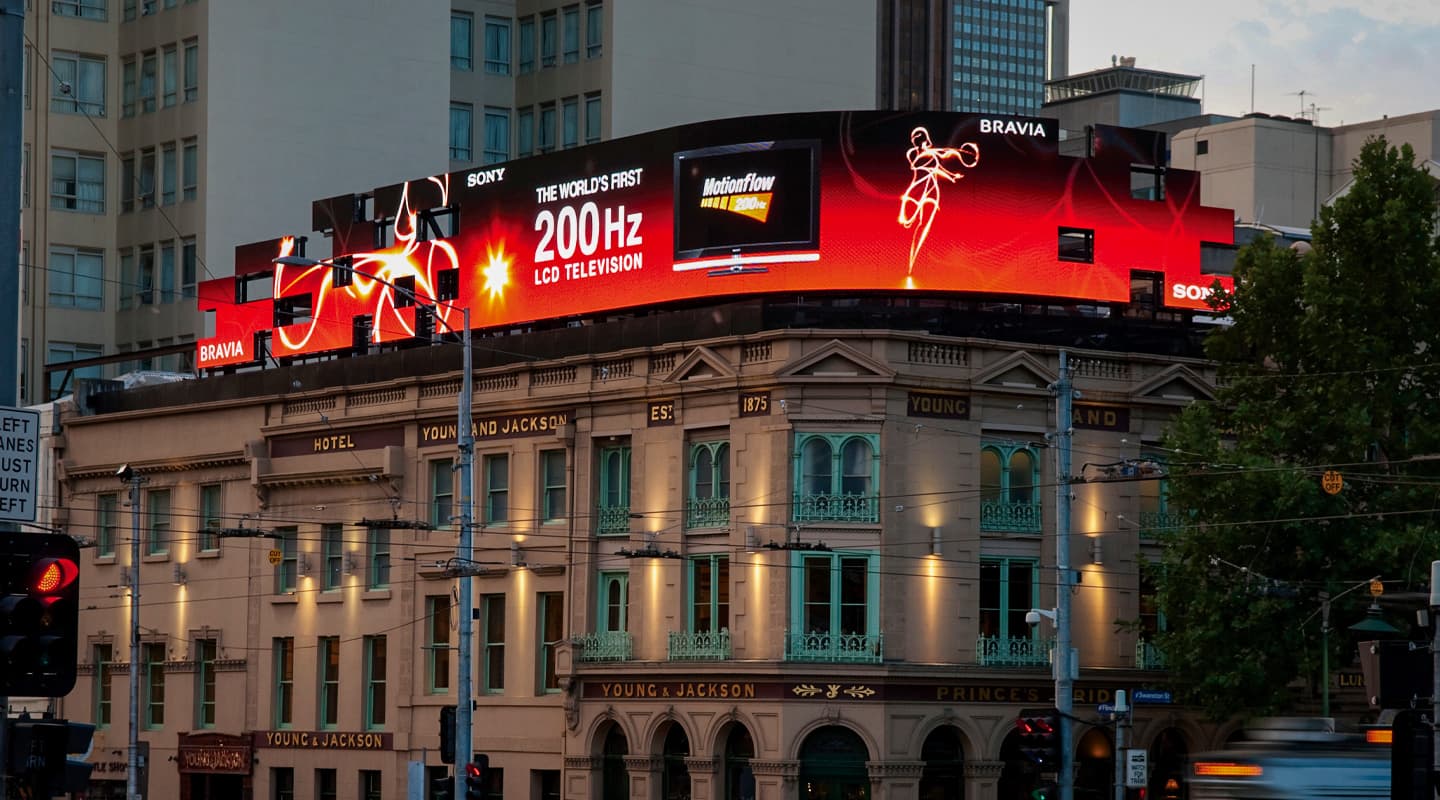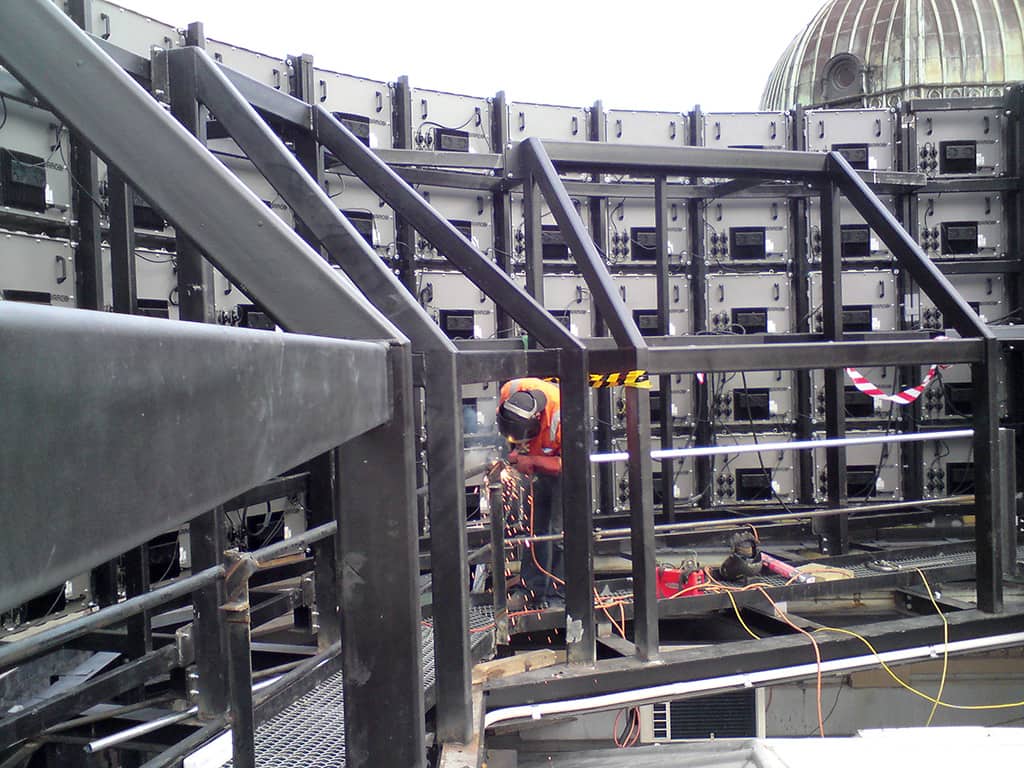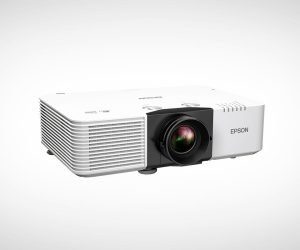
Corner the Marketing
Melbourne’s most prominent advertising signage goes digital.
Text:/ Tim Stackpool
Arguably the most commanding digital signage site in Australia today is situated on the top of the landmark Young & Jackson Hotel, opposite Melbourne’s Flinders Street station. This immense advertising display, with its screen stretching 37 metres in length and 3.5 metres high, is the brainchild of advertising media specialist APN Outdoor. After taking more than two years to obtain approval from Melbourne City Council and VicRoads to build the sign, APN Outdoor’s General Manager of Marketing, Paul McBeth says commercial reaction to the screen has been a roaring success. “We have been overwhelmed with the response and the site is heavily booked for the remainder of 2009,” he told AV.
The concept itself is a combination of design, compositing and replay software controlled via Scala digital signage software and a total of 147 Barco SLite 10XP FX LED tiles. For APN Outdoor, their technology partners and suppliers had a significant number of criteria to meet. “The primary considerations included proven international experience, where the supplier could demonstrate they had undertaken similar projects of this scale,” McBeth said. “Demonstrated reliability and durability; software and hardware that could be developed into a national network; and maximum pitch was highly important. A viewing angle enabling users to enjoy optimum viewing clarity from as many vantage points as possible was also an important consideration.”
Additionally, APN Outdoor required a screen life in the vicinity of 100,000 hours along with practical considerations, such as the ability to remove graffiti, replace tiles, together with a reliable local supply of spare parts.
Special permits and conditions had to be met due to the Young & Jackson Hotel being heritage listed. The existing structures used by previous billboards were demolished and steel reinforcement was added to the new frame structure to handle the additional weight and wind loads.
GETTING IT UP
The primary steel frames, which were to carry secondary frames populated with the Barco tiles, were manufactured off-site at Hanlon Industries in Geelong. The six primary frames, plus six sections of secondary steel frames pre-populated with tiles, were lifted by crane onto the hotel roof. This process was performed during severely restricted work hours, due to traffic management and tram operation considerations. An additional platform to accept the environmentally-controlled systems rack was also manufactured off-site and craned into position.
Craig Saunders, Barco’s Sales Engineer selected the SLite tile series with good reason. “The S10XP FX LED tile offers high resolution, virtual 10mm pitch and an IP65 rating. Being dustproof and waterproof, they’re perfect for Melbourne’s wet and hot environment,” he said. “The modularity of the tiles also allowed for creative shapes and curves.”
The digital signage system uses Scala v5 software, supplied by Techmedia, for content design and control. The system comprises three modules: Designer, Content Manager and Player. Techmedia’s Managing Director, Norman Cantrell reports that training APN Outdoor personnel on the software was swift. “The Scala 5 suite is both intuitive and powerful,” he said. “Three days was enough to orientate the creative types at APN on the Designer and Content modules, then just two days of training in Scala Player software and hardware for the Melbourne team. Apart from that, after two weeks of setup and testing, the system was underway. Considering the Scala 5 Player sits on hardware attached to the screen, Barco were also given some limited training on this module.”


FEEDING THE CONTENT
Using this software, APN Outdoor’s advertisers are given a template to develop their creative imagery and once APN Outdoor receives this, the content can be loaded onto the site within 24 hours. Advertising is scheduled for 7.5 seconds per advertiser, with eight advertisers in each 60-second loop.
From APN Outdoor’s perspective, both the technology and the social implications of the project were equally challenging. “Technically this was the first screen we had developed on this scale and as such we had to start from the ground up in understanding the technical capability, terminology and the relevance of this to the needs of our clients. Most of the key suppliers were pretty good at being able to describe in layman’s terms the technical data and its impact on our business and our end users,” McBeth said. “Bureaucratically, this was the first screen of this scale built to display third-party advertising in such a prominent location. The challenge was to dispel the myths within the local community, the City of Melbourne and the heritage authorities, as to what the screen would and would not do, and the type of content to be displayed. But once these authorities had an insight into the facts, the project began to move forward as most people began to view it as a positive development.”
KEEPING IT GOING
Managing and monitoring the site is comprehensive, with all parties including advertisers, needing to either remotely control or view the screen content as it’s displayed. This is achieved via a dedicated virtual private network connected to the IP65 climate-controlled rack on the roof of the Young & Jackson Hotel. There is a business-grade internet connection from Telstra Bigpond that allows Barco and Techmedia to receive alerts and warnings about their respective hardware. This same connection is also used by APN Outdoor to update the sign’s content.
Also wired into the control rack is a powerful wireless access point, directed across the intersection of Flinders and Swanston Streets into Federation Square. There, an Axis Dome IP camera is installed looking back at the digital signage to monitor the display, and potentially adjust settings in real-time. In addition to allowing monitoring of performance and uptime of the system and verification that the advertiser’s material is being shown, it also allows demonstrations to potential customers anywhere in the world.
The Barco DX-700 Controller and the SLite 10XPFX tiles can also transmit error and warning messages in the event of a failure. These messages are collated into an email which is generated by the Director Toolset control software. The Barco service team receive these warnings on their Blackberry PDAs, allowing them to respond immediately should a service intervention be required.
While the presence of large-scale digital signage is well established overseas, the opportunities in Australia are still in their infancy. APN Outdoor is in discussions with many stakeholders about a range of development opportunities which include digital signage. “We are witnessing a structural change in the media industry as digital technologies change the consumption patterns across traditional media,“ said McBeth. “Out-of-home is well positioned to capitalise on these changes because the combination of broadcast reach and digital technology will increase impact and enhance message relevance for many of our clients.”
Indeed, an ongoing acceptance of such large-scale digital signage represents an emerging market within cosmopolitan cities; for the advertiser, the AV installer and the supplier alike.
“”
While the presence of large-scale digital signage is well established overseas, the opportunities in Australia are still in their infancy
BARCO INSTALLATION INVENTORY:
Hardware:
147 x Barco SLite 10XP FX LED tiles
1 x Barco DX-700 Digitizer
1 x Barco Fibrelink 2 Base unit
2 x Barco Fibrelink 2 Tx units
2 x Barco Fibrelink 2 Rx units
1 x Rittal 42 RU Climate Controlled Rack
1 x APC 3000VA UPS
1 x 1RU rack server.
2 x DWL – 2700AP Wireless Access Points
1 x Axis IP Camera
Software:
Barco Director Toolset Software (Barco LED Management)
Axis IP Camera Control Software
Techmedia installation inventory:
Software:
SCALA 5 Designer software
SCALA 5 Content Manager
SCALA 5 Player software
Hardware:
Custom engineered Windows XP embedded media player















RESPONSES